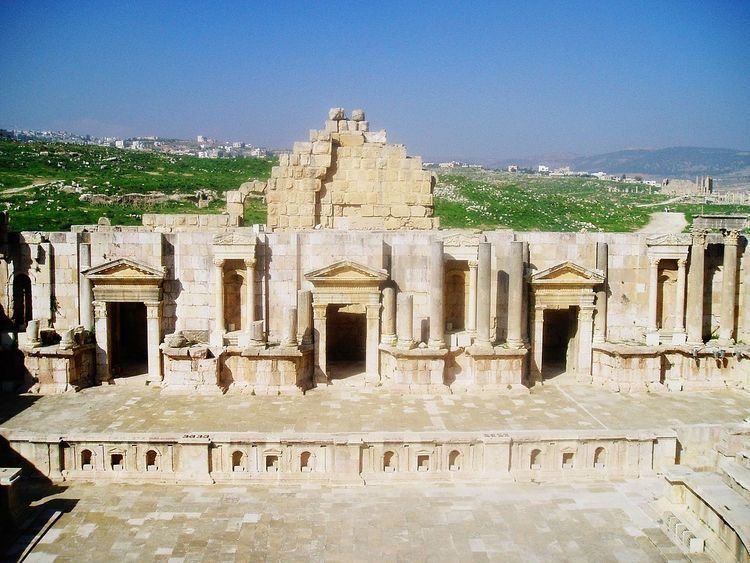 | ||
In the Theatre of Ancient Greece and classical drama, the skene was the structure at the back of a theatre stage, initially a very light structure or just cloth hanging from a rope, but by the start of Roman Greece, a large and complex stone building on several levels. The proskenion or "space in front of the skene" became, after the Classic period, the stage platform, raised above the original orchestra level.
Actors emerged from the skene and sometimes in later versions could use its steps or balconies to speak from. It was also where costumes were stored and to which the periaktoi (painted panels serving as the background) were connected. In Roman theatres, scaenae frons ("facade of the skene") is the term for the elaborately decorated stone screens, rising two or three storeys, that the skene had now become.
The word skene means "tent" or "hut," and it is thought that the original structure for these purposes was a tent or light building of wood, and was a temporary structure. Placing a skene behind the orchestra where the performers acted, played and danced broke what is thought to have been the original theatre in the round nature of Greek theatre. The skene also served as another "hidden stage." At times some of the action went on inside, in which case it was up to the audience to decide what was happening based on the noises coming from the inside. It was a convention of the dramas of the classic period that characters never died on stage, instead usually retreating into the skene to do so.
In the course of time, the skene underwent fundamental changes. First it became a permanent building, whose roof could sometimes be used to make speeches. Then it was raised up from the level of the orchestra, creating a proskenion, or "space in front of the skene". The facade of the proskenion now was behind the orchestra, and provided a space for supporting stage scenery. This facade was also sometimes elaborately decorated. The evolution of the actor, who assumed an individual part and answered to the chorus (the word for actor, hypokrites, means answerer), introduced into drama a new form, the alternation of acted scenes, or episodes. As the Greek chorus declined in importance compared to a smaller group of main actors, the chorus remained in the orchestra to perform, while the main actors generally performed from the stage on top of the proskenion. This important change occurred in the Hellenistic period, between the 3rd and 1st century BC. In surviving examples this stage seems to have been raised by 2.43 m to 3.96 m above the orchestra, and to have been from 1.92 m to 3.96 m deep, terminated by the skene. The skene itself became increasingly elaborate, and was also available as a place for actors to declaim from, so that the performers between them had three levels available.
By the 1st century BC the skene was as elaborate as its Roman development, the scaenae frons, which dispensed with the orchestra altogether, leaving a relatively low proscaenium facade, often decorated, and a wide stage or pulpitum behind, ending in an elaborate scaenae frons with three or more doors, and sometimes three storeys.
By now there was a series of complex stone buildings. To each side there was a paraskenion. The episkenion was the upper floor of the skene, which might be deepened to give a third stage level, seen through thyromata or openings. The interior of the logeion ("building") behind the skene facade remained normally outside the view of the audience, and fulfilled the original function as a changing room and place for props.
